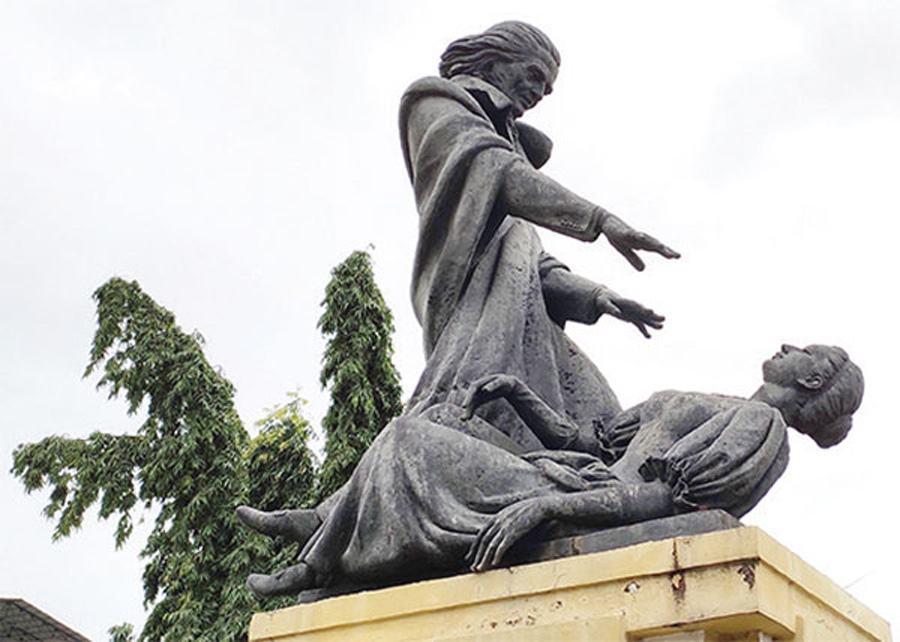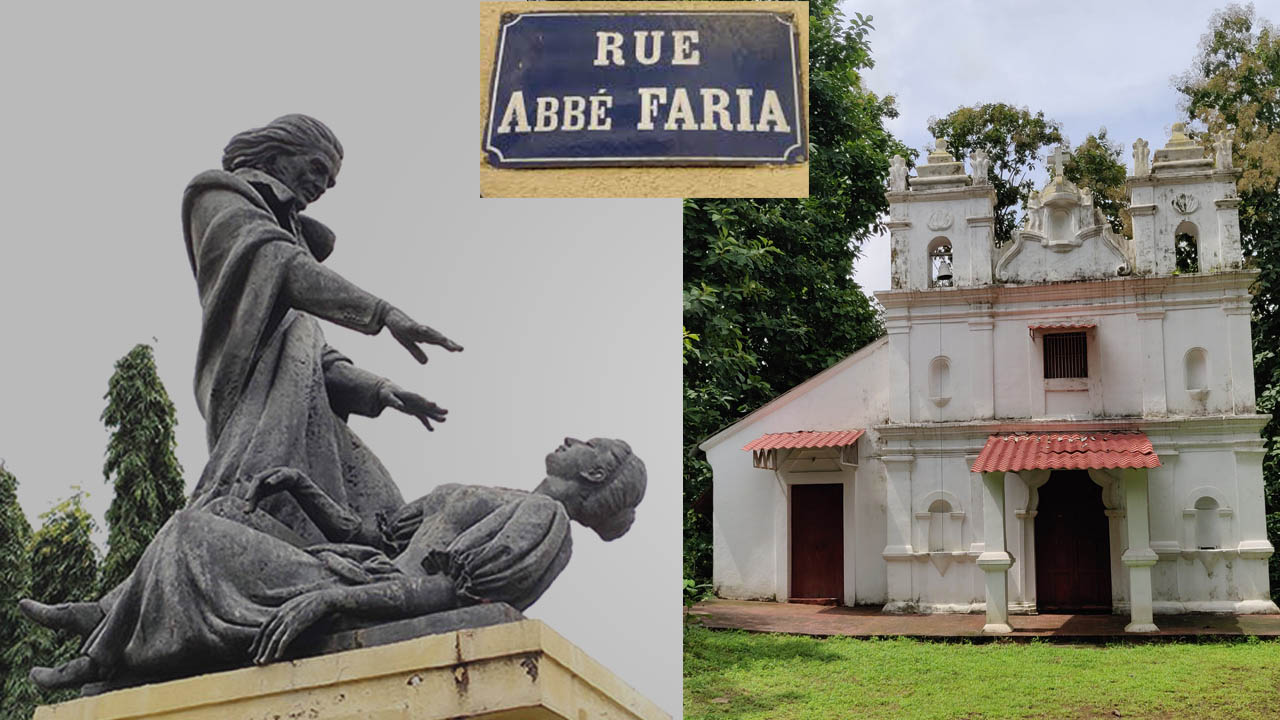Three Cheers to Abade Faria!
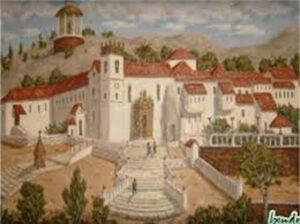
Three episodes among many others in the life of Abade Faria call for resounding cheers. The first is that he grew up under very unusual and trying circumstances, yet came out a champion. Born Joseph Custódio de Faria, in the year 1756, his parents Caetano Vitorino de Faria, who hailed from Colvale, and Rosa Maria de Souza, from Candolim, separated canonically within ten years of marriage. Thereafter, the husband took holy orders in the then seminary of Chorão; the wife joined St Monica, Asia’s largest nunnery, as a lay sister of the white veil. And the three were never together again as a family.
In such a situation, José Custódio came across as an oddity. He must have had a lot of explaining to do wherever he went. In those days, how was it to be raised by a single parent? This aspect of Goa’s forgotten celebrity hasn’t received attention from historians and psychologists. At fifteen, José Custódio travelled with his dad to Lisbon, en route to Rome. Priestly studies awaited him at the Pontifical Urban University. And both father and son secured doctorates in the Eternal City. The young man left no stone unturned in his solitary yet creative life.
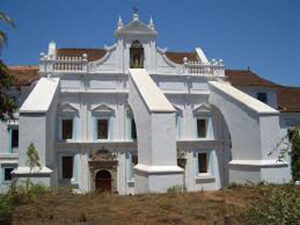
The second reason to celebrate Abade Faria is that he sailed uncharted seas. He spent eight years (1780-88) with his nativist father, who was considered the ‘patriarch and patron’ of the Goan community in Lisbon. Then, Faria Jr. went to France, in search of greener pastures. His arrival coincided with the political turmoil of the Revolution, when royalists and clergy alike were getting a raw deal. He bided his time until 1795 when he placed himself at the head of a revolutionary battalion and marched against the National Convention. The five-member Directory that seized power ended the Reign of Terror; they also relaxed the measures that had been instituted against exiled priests and monarchists. Fr. José Custódio de Faria thus had the curious distinction of being the one and only Goan participant in the French Revolution.
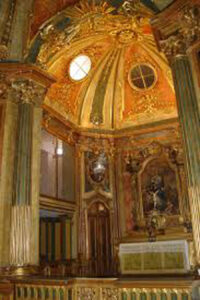
By now, the Goan cleric was ‘Abbé Faria’ to everyone. ‘Abbé’ is French for priest or abbot; in Portuguese they wrongly called him ‘Abade’ (abbot), which he was not! As though compensating for that mistranslation, the father’s clarion call in Konkani was properly captured by bystanders: “Hi soglli bhaji… Kator re bhaji!” – ‘Strawheads all, chop them off!’ And that’s how a concerned father rescued his preacher son awestruck in the pulpit, before the Queen and the nobility gathered in the royal chapel at Queluz, Portugal.
There is no hard evidence to support that claim but the senior Faria’s alleged cry has long been part of the Goan lore. I have a hunch that this set the ball rolling for an unprecedented career for the junior Faria. That legendary transformation brought about by half a dozen, suggestive words uttered by a devoted father must have rung in the son’s ears for a long time to come. It may be facile to connect the episode to the theory of hypnotism by suggestion that Abade Faria pioneered, but here it goes nonetheless!
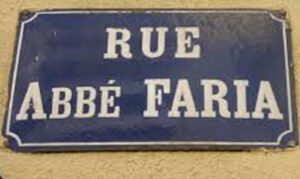
After a stint as professor of philosophy in the port city of Marseilles in 1811, the Abbé finally settled down in Paris where he gave sessions of hypnotism. He died there in 1819, but not before rejecting Mesmer’s animal magnetism and expounding a new theory of hypnotism. Faria put the subject on a sound footing, coining the term sommeil lucide (lucid sleep). He dwelt on this at length in his magnum opus, titled De la cause du sommeil lucide ou étude de la nature de l’homme, that is, ‘Of the Cause of Lucid Sleep or Study of the Nature of Man’, which was published posthumously. And it is a pity that the remaining three volumes never saw the light of day.
Abade Faria made a seminal contribution to the field of science. Hypnosis soon became a vital aid to physiology and medicine, and is still so to psychiatry, psychoanalysis and surgery. No doubt, the discoverer was initially derided by doctors, writers, and pastors, but the scientist came out victorious. Today, he is universally regarded as the ‘father of modern hypnotism’.
Three cheers, then, to the greatest untrained Goan scientist of all times, on his 200th death anniversary today!
(The Goan, 20 September 2019)
http://epaper.thegoan.net/2335415/The-Goan-Everyday/The-Goan-Everyday#page/10/1
When I met Abade Faria...
I lived next door to Abade Faria for thirty years. As a child, I remember asking my father what that name meant. Keen on passing on informatio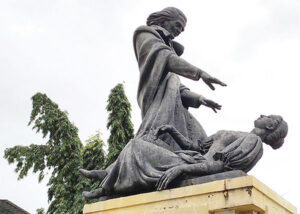 n about our land and our people, Papa said he was a priest who had the distinction of being the discoverer of hypnotism. As for me, I didn’t quite like to see Faria in that strange pose. It was terrifying to see that lady tumbling down before his very eyes; it even seemed like he had knocked her down. But then, I wouldn’t speak ill of my neighbour, or ask odd questions…
n about our land and our people, Papa said he was a priest who had the distinction of being the discoverer of hypnotism. As for me, I didn’t quite like to see Faria in that strange pose. It was terrifying to see that lady tumbling down before his very eyes; it even seemed like he had knocked her down. But then, I wouldn’t speak ill of my neighbour, or ask odd questions…
Abade Faria is that very striking statue in the heart of Panjim. I couldn’t have met the man himself: José Custódio de Faria was born in 1756, at his mother’s house in Candolim. His father was from a less known village, Colvale. As I came of age, I learnt that he was the son of a priest and a nun… Hold on! They were ‘normal’ people, Caetano Vitorino de Faria and Rosa Maria de Souza, who got married, had a child, and then broke up. The father took holy orders at the then Chorão seminary while the mother joined St Monica, Asia’s largest nunnery, at Old Goa.
The father-son duo then travelled to Lisbon, and onward to Rome, where Faria Jr. was ordained a priest and the father-son duo did their doctorates in theology. On their return to Lisbon, the father was left harbouring nativist ideas; the son, seeking a safe harbour, proceeded to France, in 1788.
That’s how the name ‘Abbé Faria’ makes sense. The French word for ‘priest’ is still in vogue in the English-speaking w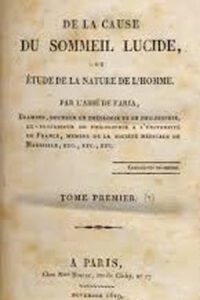 orld. Faria spent the last three decades of his life in Paris, Marseilles and Nîmes. In the midst of the Revolution, he was attracted to magnetism. ‘Magnetism’ was the older word for hypnotism, which the Abbé reinterpreted as “sommeil lucide” (lucid sleep) in his magnum opus De la cause du sommeil lucide ou étude de la nature de l’homme (Of the Cause of Lucid Sleep or Study of the Nature of Man), published posthumously.
orld. Faria spent the last three decades of his life in Paris, Marseilles and Nîmes. In the midst of the Revolution, he was attracted to magnetism. ‘Magnetism’ was the older word for hypnotism, which the Abbé reinterpreted as “sommeil lucide” (lucid sleep) in his magnum opus De la cause du sommeil lucide ou étude de la nature de l’homme (Of the Cause of Lucid Sleep or Study of the Nature of Man), published posthumously.
In 1988, as I arrived in France, Faria’s poignant story raced through my mind like a film. It was exactly two centuries since the only Goan who participated in the Revolution had stepped into Paris. Alas, I found no trace of his addresses in that magnificent global city. So I was hopeful about seeing the Abbé next in the luminous port city of Marseilles. My joy knew no bounds when I finally sighted a street named after him.
There I was quizzing a few pedestrians on that sleepy thoroughfare. When the very first speaker confessed his ignorance, I was crestf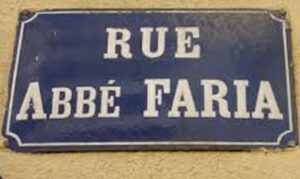 allen. But I bounced back on hearing my next interlocutor wax eloquent on the Abbé as a hypnotiser figuring in Chateaubriand’
allen. But I bounced back on hearing my next interlocutor wax eloquent on the Abbé as a hypnotiser figuring in Chateaubriand’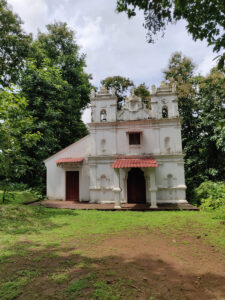 s memoirs and in Alexandre Dumas’ adventure novel The Count of Monte Cristo.
s memoirs and in Alexandre Dumas’ adventure novel The Count of Monte Cristo.
My third and final encounter was most memorable. When I fired my standard question – ‘Who is this Abbé Faria?’ – the man playfully shot back at me, saying, ‘He was an Indian – like you!’ And with a smile playing on his lips, he vanished into thin air, while I was stuck in a hypnotic state!
Back in Goa, my interest in Faria redoubled. One fine afternoon, very significantly, the fourth of July, my fiancée came along to see my friend Abade Faria in Colvale. Just locating his family estate in that northernmost village of Bardez took us longer than getting there all the way from Panjim. It felt as though we were searching for something in pitch darkness, no flashlights in hand, when really it was broad daylight… What an exploration indeed!
Renowned historian J. N. da Fonseca, who purchased the Faria estate in the nineteenth century, built a house there, possibly on the ruins of the hypnotiser’s family house. Only the private chapel was spared.
When I was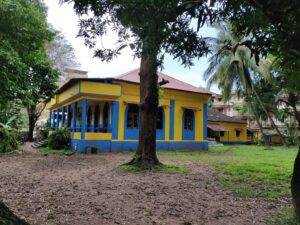 working on an article for the fortnightly Herald Illustrated Review, way back in 1995, I also visited the Souza house in Candolim, now an orphanage. It’s still the same today. Not a pretty sight, but there is at least a plaque m
working on an article for the fortnightly Herald Illustrated Review, way back in 1995, I also visited the Souza house in Candolim, now an orphanage. It’s still the same today. Not a pretty sight, but there is at least a plaque m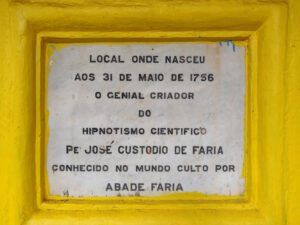 arking the birth of Goa’s most eminent, self-trained scientist who left his footprints on the sands of time.
arking the birth of Goa’s most eminent, self-trained scientist who left his footprints on the sands of time.
So, you see, it was great getting to know Abade Faria – my civic duty, to say the least. You too can trail him now. Begin today, on his 200th death anniversary.
(Herald Café, 20 September 2019, p. 1)
https://www.heraldgoa.in/Cafe/WHEN-I-MET-ABADE-FARIA%E2%80%A6/151383
